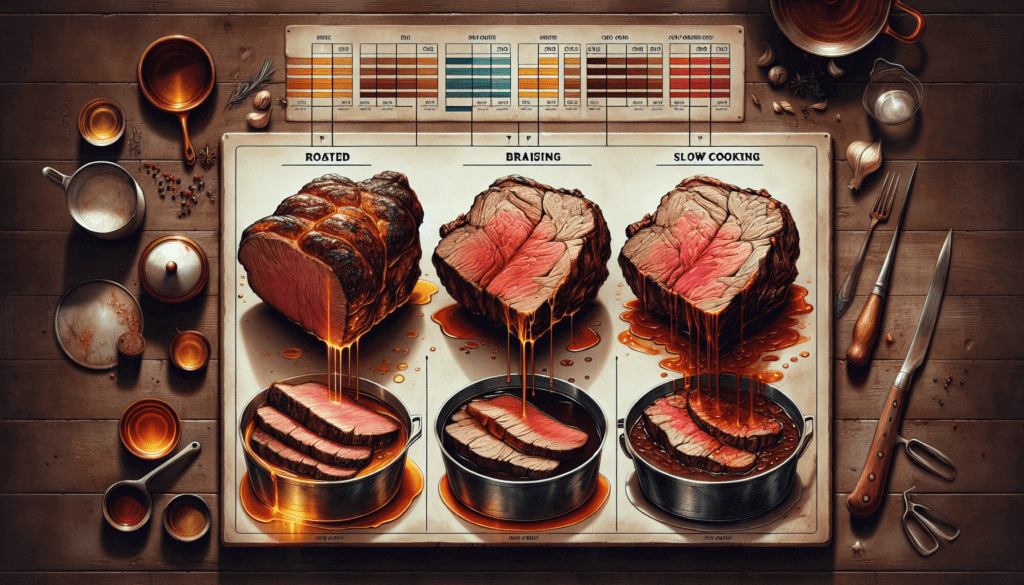If you’re a fan of juicy and flavorful roast beef, then you’re in for a treat! In this article, you’ll discover the best ways to cook classic roast beef that will leave you wanting more. Whether you prefer a perfectly tender rare roast or a well-done, caramelized crust, we’ve got you covered. Get ready to tantalize your taste buds and impress your guests with these tried and true methods for cooking the perfect classic roast beef.
Choosing the Right Cut of Beef
When it comes to cooking classic roast beef, one of the first things you need to consider is the cut of beef you will be using. Different cuts of beef have different characteristics that can affect the taste and texture of your roast. Some cuts are more tender and flavorful, while others may require longer cooking times to achieve the desired tenderness.
To choose the right cut of beef for your roast, it’s important to understand the different cuts available. Common cuts for roasts include ribeye, tenderloin, sirloin, and chuck. Ribeye is known for its marbling and rich flavor, while tenderloin is one of the most tender cuts of beef. Sirloin is a versatile cut that can be used for roasts, and chuck is a more economical option that requires slower cooking to achieve tenderness.
Consider your budget when selecting the cut of beef. Different cuts can vary greatly in price, so it’s important to choose one that fits within your budget. While some cuts may be more expensive, they often offer superior flavor and tenderness. However, there are plenty of affordable options available that can still result in a delicious roast.
To make an informed decision, seek advice from your local butcher. They are experts in their field and can provide valuable insights on the different cuts of beef available, as well as recommendations based on your specific preferences and budget. Don’t hesitate to ask them questions about the cuts and cooking methods to ensure you choose the best cut for your classic roast beef.
Preparing the Beef
Once you’ve chosen the perfect cut of beef for your classic roast, it’s important to properly prepare it before cooking. Taking the time to prepare the beef correctly can enhance its flavors and ensure a juicy and tender roast.
One important step is to bring the beef to room temperature before cooking. Allowing it to sit at room temperature for about 30 minutes to an hour before cooking will ensure that the meat cooks more evenly. This is especially important for thicker cuts of beef, as cooking them straight from the refrigerator can result in an unevenly cooked roast.
Before cooking, it’s also a good idea to trim excess fat from the beef. While fat adds flavor to the roast, too much can result in a greasy and unappetizing texture. Use a sharp knife to carefully remove any excess fat, leaving just enough to add flavor and moisture to the roast.
When it comes to seasoning your beef, the choice is yours. Classic roast beef can be seasoned simply with salt and pepper, or you can experiment with a variety of herbs and spices to add extra flavor. Consider using a dry rub or marinating the meat overnight to infuse it with even more delicious flavors. The key is to choose seasonings that complement the natural flavors of the beef without overpowering them.

Cooking Methods
There are several different cooking methods that can be used to cook classic roast beef, each with its own unique benefits and techniques. The most common methods include oven roasting, slow cooking, and grilling.
Oven roasting is a popular method for cooking roast beef as it allows for even cooking and a nice crust to form on the outside of the meat. Slow cooking, on the other hand, is ideal for tougher cuts of beef that require a longer cooking time to become tender. Grilling is a great option for those who enjoy the smoky flavors and charred edges that can only be achieved on a grill.
Each cooking method requires specific techniques and considerations to ensure a perfectly cooked roast beef. Let’s take a closer look at each method and how to master it.
Oven Roasting Techniques
Oven roasting is a classic and foolproof method for cooking roast beef. It allows for precise temperature control and even heat distribution, resulting in a tender and juicy roast with a delicious outer crust.
To begin, preheat the oven to the desired temperature. This will depend on the cut of beef and your preferred level of doneness. A general guideline is to preheat the oven to 425°F (220°C) for a medium-rare roast, but adjust the temperature accordingly to achieve your desired level of doneness.
Using a roasting pan is recommended for oven roasting. The pan should be large enough to comfortably fit the roast, allowing air to circulate around it. This promotes even cooking and allows the fat to render and drip away from the meat, preventing it from becoming greasy.
When roasting beef in the oven, it’s essential to use a meat thermometer to ensure the roast reaches the desired internal temperature. This will depend on the level of doneness you prefer. Insert the meat thermometer into the thickest part of the roast, being careful not to touch the bone if the roast has one. Once the roast reaches the desired temperature, remove it from the oven and let it rest before carving.

Slow Cooking Tips
Slow cooking is a great method for cooking tougher cuts of beef that require longer cooking times to become tender. It allows the meat to cook slowly over low heat, resulting in a succulent and melt-in-your-mouth roast.
When it comes to slow cooking, selecting the right slow cooker is key. Choose a slow cooker that is large enough to comfortably fit the roast, allowing room for the meat and any additional ingredients. Look for a slow cooker with adjustable temperature settings, as this will give you more control over the cooking process.
Setting the cooking time for a slow-cooked roast is important to achieve the desired tenderness. Most slow cookers have low and high temperature settings. For a tender roast, cook it on the low setting for 8-10 hours. If time is a constraint, you can use the high setting and cook the roast for 4-6 hours. Keep in mind that the low and slow method will result in a more tender roast.
To ensure a moist roast when slow cooking, consider adding some moisture to the slow cooker. This can be done by adding broth, wine, or even a mixture of herbs and spices to the bottom of the slow cooker. As the roast cooks, the liquid will create steam, keeping the meat moist and preventing it from drying out.
Grilling Basics
Grilling is a fantastic option for cooking classic roast beef, especially for those who enjoy the unique flavors and charred edges that can only be achieved on the grill. Whether you use a charcoal or gas grill, mastering the basics of grilling roast beef can result in a flavorful and visually stunning dish.
To start, choose the right grill for the task. Both charcoal and gas grills work well for grilling roast beef, so it’s a matter of personal preference. Charcoal grills provide an intense smoky flavor, while gas grills offer convenient temperature control. Whichever grill you choose, make sure it is clean and properly maintained to ensure even cooking.
Before grilling, preheat the grill on high for about 10-15 minutes. This will ensure that the grill grates are hot and provide a good sear on the roast. Proper preheating is also important for food safety, as it helps to kill any bacteria that may be present on the grill grates.
When grilling roast beef, you have the option to use either direct or indirect heat. Direct heat involves placing the roast directly over the flames, while indirect heat involves placing the roast to the side of the flames. Both methods have their advantages and can produce excellent results, so choose the method that best suits your preferences and the cut of beef you are using.

Perfect Internal Temperatures
Achieving the perfect internal temperature is crucial for cooking classic roast beef to your desired level of doneness. Different degrees of doneness are determined by the internal temperature of the roast.
For a rare roast, the internal temperature should reach about 125°F (52°C). This will result in a vibrant red center and a very juicy roast. If you prefer a medium-rare roast, aim for an internal temperature of about 135°F (57°C). This will give you a warm pink center with a slightly firmer texture.
Medium roast beef is achieved at an internal temperature of around 145°F (63°C). At this temperature, the meat will be pink throughout and offer a tender and juicy bite. For those who prefer a slightly more well-done roast, aim for a medium-well temperature of around 155°F (68°C). This will give you a roast with a hint of pink and some residual juiciness.
If you prefer your roast to be well-done, cook it until the internal temperature reaches about 160°F (71°C) or higher. Keep in mind that cooking a roast to well-done may result in a drier texture, so it’s important to choose a tender cut of beef and employ cooking methods that lock in moisture to prevent it from drying out.
Resting and Carving
After your classic roast beef is cooked to perfection, it’s crucial to let it rest before carving. Resting allows the juices in the meat to redistribute, resulting in a more flavorful and tender roast. It also gives the meat time to relax, making it easier to carve without losing its shape or texture.
To let the roast rest, carefully transfer it to a cutting board or a platter and cover it loosely with aluminum foil. Let it rest for about 15-20 minutes. During this time, the internal temperature of the meat will continue to rise slightly, so keep this in mind when considering the desired level of doneness.
When it comes to carving your classic roast beef, it’s important to use the right techniques and follow some tips to ensure the best results. Begin by using a sharp carving knife to create neat slices. Aim for slices that are about a quarter to a half-inch thick. Cut against the grain of the meat for the most tender and flavorful slices.
If you’re unsure of the grain’s direction, look for the lines and striations in the meat. These lines usually run parallel to each other, and cutting across them will result in more tender slices. Remember to slice only what you need and leave the rest of the roast intact to retain the moisture and enhance the flavor.

Classic Roast Beef Recipes
Now that you have a solid understanding of the different cooking methods and techniques for classic roast beef, it’s time to explore some delicious recipes. Here are three classic roast beef recipes to try:
Traditional Sunday Roast
This recipe is perfect for a special Sunday family gathering. Season a tender cut of beef with salt and pepper, and optionally add garlic and your choice of herbs. Roast it in the oven until it reaches your desired internal temperature. Serve with roasted potatoes, Yorkshire pudding, and a selection of seasonal vegetables for a truly comforting meal.
Herb-Crusted Roast Beef
For a flavor-packed roast beef, try an herb-crusted variation. Create a rub with a mixture of your favorite herbs, such as rosemary, thyme, and parsley, along with garlic and olive oil. Generously coat the roast with the herb rub, then roast in the oven until it reaches your desired level of doneness. The herb crust will infuse the beef with incredible flavors, resulting in a mouth-watering roast.
Garlic and Rosemary Roast Beef
Garlic and rosemary are a classic flavor combination that pairs beautifully with roast beef. Create a marinade with garlic, rosemary, olive oil, salt, and pepper. Let the roast marinate for at least a few hours or overnight in the refrigerator. When ready to cook, remove the roast from the marinade and roast in the oven until it reaches the desired internal temperature. The garlic and rosemary will permeate the meat, creating a roast beef with a wonderful aroma and taste.
Serving Suggestions
To complete your classic roast beef meal, consider accompanying it with some delicious side dishes and flavorful sauces.
Accompaniments
Classic roast beef pairs well with a variety of side dishes. Consider serving it with creamy mashed potatoes, roasted vegetables, Yorkshire pudding, or a fresh salad. These sides will help balance the rich flavors of the roast and add additional textures and colors to your plate.
Gravy and Sauces
Gravy and sauces can take your classic roast beef to the next level. A rich homemade gravy made with the pan drippings and beef broth is a popular choice. Other options include horseradish cream sauce, chimichurri, or a classic red wine reduction. These sauces can complement the flavors of the beef and add an extra burst of taste.
With these tips and recipes, you’re well-equipped to cook a delicious and memorable classic roast beef. Enjoy the process of selecting the perfect cut of beef, preparing it with care, and experimenting with different cooking methods and flavors. Whether you’re serving it for a special occasion or a comforting Sunday dinner, your roast beef is sure to impress. Happy cooking!



